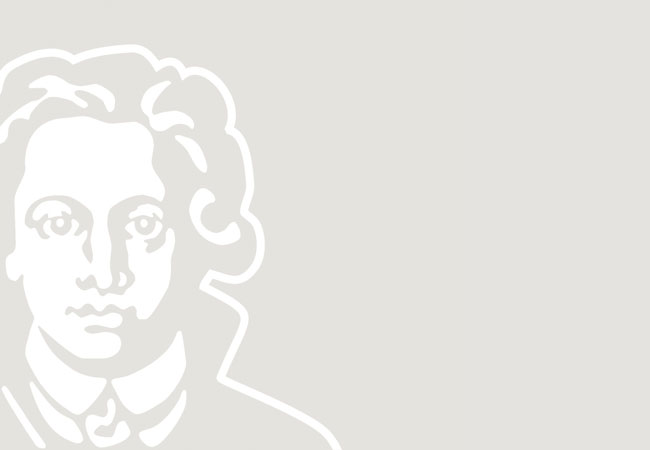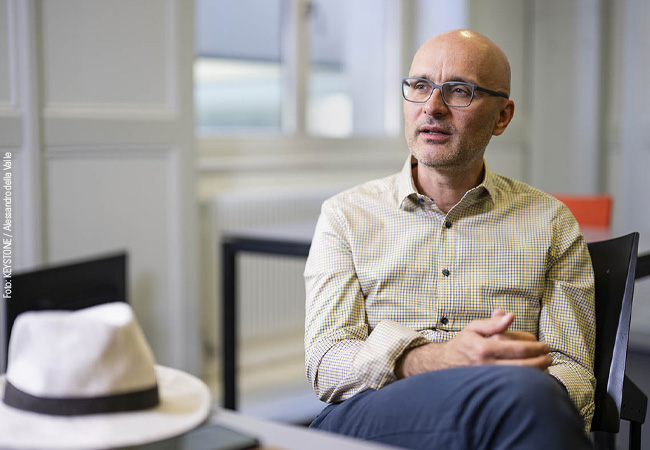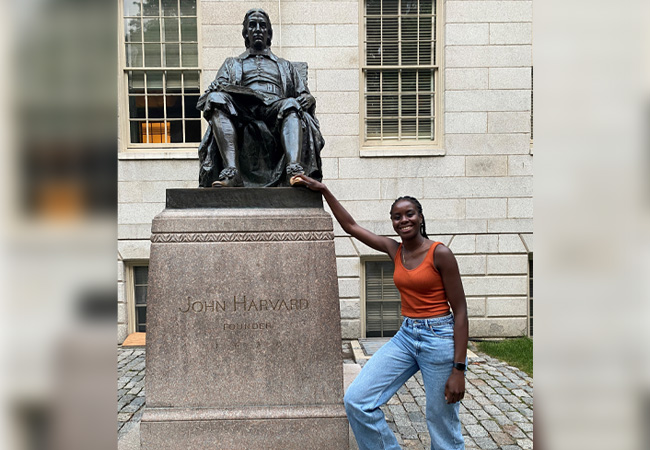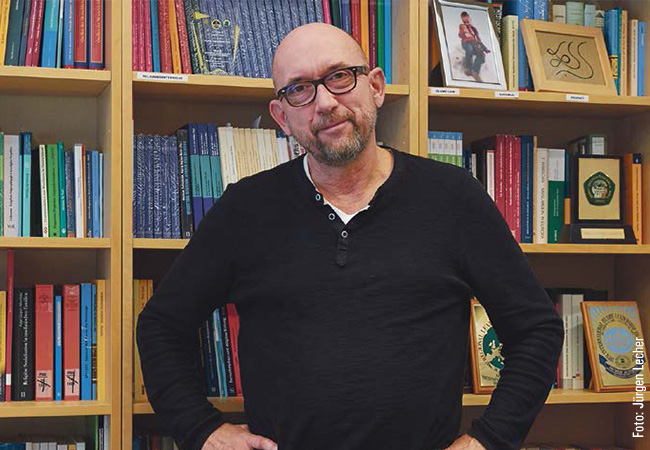Art historian and curator Ina Neddermeyer will take over as director of Museum Giersch of Goethe University (MGGU) in January 2024
UniReport: Ms. Neddermeyer, after having studied art history, politics and philosophy, you worked primarily as a curator.

Ina Neddermeyer: That is correct. Actually, my studies were very interdisciplinary, and put artistic positions into an overall social context. That’s also the case in my current work as head of the Zeppelin Museum’s art department. Over the course of my career, I have also curated classical art history exhibitions, including on Willi Baumeister, Otto Dix and Marta Hoepffner – who incidentally was a Frankfurt artist.
But the exhibition program has much more to offer, also thanks to its interdisciplinary nature, with a strong focus on social topics. An exhibition about mining in the future has just ended, and we’re in the midst of preparing an exhibition on the topic of blockchain. Before that, we had exhibition projects dealing with the “limits of statehood” and drone technologies. Rather than being pure art exhibitions, we instead tried to examine the topics from entirely different perspectives – an approach that is characteristic of my style as a curator and will come in handy for my new job in Frankfurt.
Museums have to hold their own in a tough market. Several top-class museums line Frankfurt’s “Museumsufer” – creating a certain kind of competition. What is your view of this cluster, unique in Germany?
I don’t see the density of museums as competition at all, but – and this may have something to do with me coming from the world of museums – rather as enrichment. This huge variety makes Frankfurt an attractive destination for visitors from near and far. If you visit Museum Giersch, for instance, you can also visit the Städel or one of Frankfurt’s other museums. That’s also something I hear from visitors: they appreciate museums that offer variety, where they can see several different things during one visit. That being said, however, one aspect we should consider more in the future is cooperative projects for making even better use of these synergies. Its close ties with Goethe University are certainly one of MGGU’s unique selling points. But we should go beyond the image of us being a “window to the university”. We want to bring people together, so we are more like the “door to the university”.
How can art exhibitions and scientific discourse become even closer aligned – do you have ideas for possible formats?
My approach would be to bring the two together through topical alignment, i.e. identifying what topics already exist at the university, and where their social relevance can be found in either research questions or courses. Which of those aspects would be good both for the university and for the museum? Where are the interfaces and what could we establish through them? What about Goethe University’s excellent collections – where do they offer starting points for exhibitions or create space for encounters in a museum context? If a thematic relevance can be identified and developed, then the museum would be a place for exchange and interaction both for students and for researchers, and would also become more interesting to Frankfurt’s civil society. In the first few months, I am planning to take a closer look at which formats have already been tested, which worked and which didn’t, and why. We don’t have to reinvent everything – we can build on experience.
All the same, as a format, the exhibition offers a lot of room for implementation. We can also take this one step further, and think about which artists are working right at the interface between university research and a sociopolitical topic: their artistic positions could, in a way, act as aesthetic forms of research. Artist residencies, for example, where artists cooperate on-site with scientists, could enable more intensive and focused work on certain topics and simultaneously develop new forms of presentation and communication.
Frankfurt is a city with many graduates and a large, well-educated middle class. Yet, at the same time, education is not accessible to all: certain – at times invisible – barriers remain. How could museums be opened up and made more accessible?
Every cultural institution should of course be open to all sections of the population. How can we reach as many people as possible? I think the best way to do that is by connecting with people’s real lives, i.e. by asking what topics occupy them right now. One example would be the extraction of resources, a topic on which a lot of research is being conducted, but which of course also a very practical, real-life dimension: How do we handle resources, how do we use recycling? In the Zeppelin Museum, we were fortunate that a recent exhibition on this subject drew a huge number of visitors with a wide variety of backgrounds, some 72,000 in total. Focusing on a topic relevant to everyday life means opening it up to a large group of people to join in.
We often look at a person’s first 100 days in office. What do you plan to do during this period?
I’m planning to have lots of discussions and to listen carefully, starting with my new team. I’m also really looking forward to talking with colleagues from other museums. I’d like to understand the needs of the museum, the university and Frankfurt’s citizens. I’m looking forward to Museum Giersch, the dialog with the Giersch Foundation, and also to Frankfurt and its rich cultural life.
Are there any hidden gems in Museum Giersch that could still be unearthed?
Museum Giersch is already unique, not least because it is a living part of the university. In addition, it also has a great location in Frankfurt’s unique museum landscape, and its space offers much room for all sorts of things. What makes the museum interesting to artists is its history – we are not talking here about a white cube. The museum’s exhibitions to date have also been exciting, because they showcased artistic positions that had been somewhat forgotten. Incidentally, this practice also in effect performed some important underlying work, by putting specific artists back into the limelight. It’s incredibly important to create this visibility and I’d like to build on that. One thing we can definitely develop is the relationship to the university, i.e. how do we bring both players together to deepen their ties even further, and set the groundwork for the museum to become an important place for discourse in the university? We plan to set up a founding board in 2024, comprised of students, research assistants and professors, and designed to foster interaction between museum and university.
Another aspect is accessibility. The museum’s entryway still feels somewhat “exclusive” – which is definitely linked to the building being a protected monument. We could also think about how to improve the quality of a visit; one example would be to introduce gastronomy. Other types of events and communication formats could also help make the museum even more of a living location where people spend their time and engage in dialog.
Do you already have concrete ideas for upcoming exhibitions or activities?
There’s a whole series of ideas, but they’re not yet ready to be finalized. Apart from that, the curators have already made major preparations for next year. One overarching topic that could play a major role in the future would be “Futures.” I feel like this is a pivotal topic at universities, and one, which several research groups are working on. Incidentally, it also played an important role in my work as a curator. What will determine how we live our lives? What will future models for society look like; what resources would they need, and what technologies? That is something I for one find extremely exciting.
Questions: Dirk Frank
Ina Neddermeyer studied art history, politics and philosophy in Berlin and Florence. Following a period in museum research, she worked as collection curator at the Kunstpalais in Erlangen from 2013 to 2016. From then until 2023, she worked as curator and head of the Art Department at the Zeppelin Museum in Friedrichshafen. She has curated numerous exhibitions, including individual expositions by Otto Dix, Marta Hoepffner, Peter Land and Reynold Reynolds, and group exhibitions such as “Into the deep. Mines of the future,” “Beyond States. On the limits of statehood,” “Game of Drones. Of Unmanned Aerial Vehicles” and “Beautiful New Worlds. Virtual Realities in Contemporary Art.”













